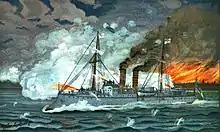SMS Iltis
SMS Iltis was the lead ship of the Iltis class of gunboats built for the German Kaiserliche Marine (Imperial Navy) in the late 1890s and early 1900s. Other ships of the class are SMS Luchs, SMS Tiger, SMS Eber, SMS Jaguar, and SMS Panther.
 1902 lithograph of Iltis | |
| History | |
|---|---|
| Name: | SMS Iltis |
| Namesake: | SMS Iltis |
| Builder: | Schichau-Werke, Danzig |
| Laid down: | 1897 |
| Launched: | 4 August 1898 |
| Commissioned: | 1 December 1898 |
| Fate: | scuttled on 28 September 1914 |
| General characteristics | |
| Class and type: | Iltis-class gunboat |
| Displacement: | 1,048 t (1,031 long tons) |
| Length: | 65.2 meters (214 ft) o/a |
| Beam: | 9.1 m (30 ft) |
| Draft: | 3.59 m (11.8 ft) |
| Installed power: |
|
| Propulsion: | |
| Speed: | 14.8 knots (27.4 km/h; 17.0 mph) |
| Range: | 3,080 nautical miles (5,700 km; 3,540 mi) at 9 knots (17 km/h; 10 mph) |
| Complement: |
|
| Armament: |
|
Design
Iltis was 65.2 meters (214 ft) long overall and had a beam of 9.1 m (30 ft) and a draft of 3.59 m (11.8 ft) forward. She displaced 1,048 metric tons (1,031 long tons; 1,155 short tons) at full load. Her propulsion system consisted of a pair of horizontal triple-expansion steam engines each driving a single screw propeller, with steam supplied by four coal-fired Thornycroft boilers. Iltis could steam at a top speed of 14.8 knots (27.4 km/h; 17.0 mph) at 1,378 metric horsepower (1,359 ihp). The ship had a cruising radius of about 3,080 nautical miles (5,700 km; 3,540 mi) at a speed of 9 knots (17 km/h; 10 mph).[1] She had a crew of 9 officers and 121 enlisted men.[2] Iltis was armed with a main battery of four 8.8 cm (3.5 in) SK L/30 guns, with 1,124 rounds of ammunition. She also carried six machine guns.[1][3]
Service history

Iltis was laid down at the Schichau-Werke shipyard in Danzig in 1897. She was launched on 4 August 1898 and commissioned into the German fleet on 1 December that year. After entering service, Iltis was sent abroad,[4] to Germany's main naval force in Asia, the East Asia Squadron. Shortly thereafter, the Boxer Rebellion broke out in China. At the time, the East Asia Squadron also included the protected cruisers Kaiserin Augusta, Hansa, Hertha, and Irene, the unprotected cruiser Gefion, and the gunboat Jaguar.[5] Kaiser Wilhelm II decided that an expeditionary force was necessary to reinforce the Eight Nation Alliance that had formed to defeat the Boxers. The expeditionary force consisted of the four Brandenburg-class battleships, six cruisers, 10 freighters, three torpedo boats, and six regiments of marines, under the command of Marshal Alfred von Waldersee.[6]
After the outbreak of World War I in early August 1914, the light cruiser Emden captured the Russian steamer Ryazan and brought her back to Tsingtao. Men from the crews of Iltis, the unprotected cruiser Cormoran and the gunboat Vaterland were used to man Ryazan, which was commissioned as the auxiliary cruiser Cormoran.[7] Iltis was then scuttled on 28 September 1914 during the Siege of Tsingtao. Three of her sisters were also scuttled during the siege.[2]
Notes
- Gröner, p. 142
- Gröner, p. 143
- Gardiner, p. 260
- Gröner, pp. 142–153
- Perry, p. 28
- Herwig, p. 106
- Hildebrand, Röhr, & Steinmetz, p. 196
References
- Gardiner, Robert, ed. (1979). Conway's All the World's Fighting Ships: 1860–1905. London: Conway Maritime Press. ISBN 0-85177-133-5.
- Gröner, Erich (1990). German Warships: 1815–1945. Vol. I: Major Surface Vessels. Annapolis: Naval Institute Press. ISBN 0-87021-790-9.
- Herwig, Holger (1998) [1980]. "Luxury" Fleet: The Imperial German Navy 1888–1918. Amherst: Humanity Books. ISBN 978-1-57392-286-9.
- Hildebrand, Hans H.; Röhr, Albert; Steinmetz, Hans-Otto (1993). Die Deutschen Kriegsschiffe. 2. Ratingen: Mundus Verlag. ISBN 978-3-8364-9743-5.
- Perry, Michael (2001). Peking 1900: the Boxer rebellion. Oxford: Osprey Publishing. ISBN 978-1-84176-181-7.